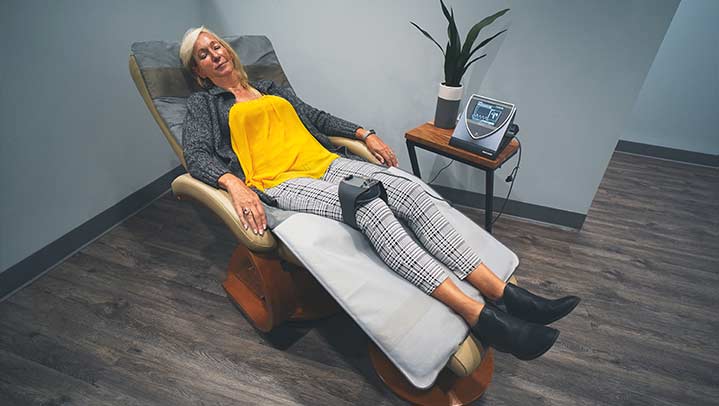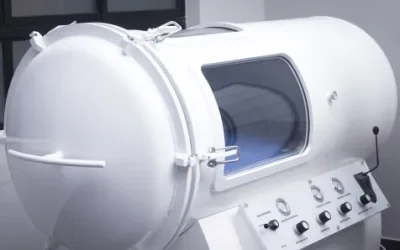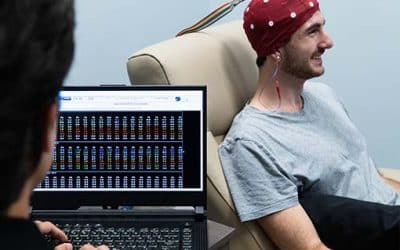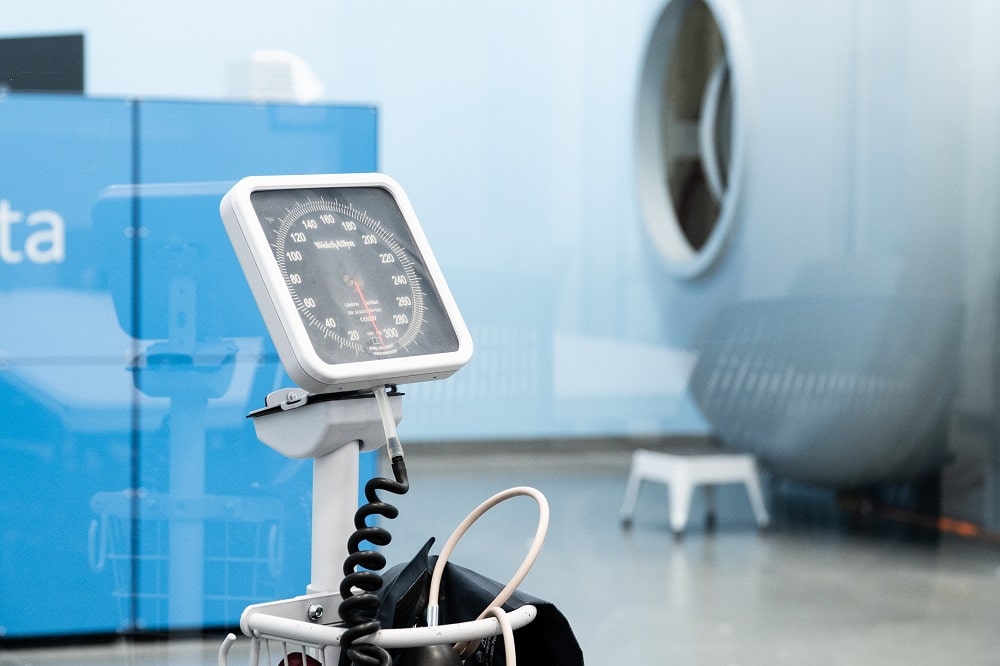Fibromyalgia
Fibromyalgia is a condition that is characterized by wide-spread pain, typically accompanied by fatigue, cognitive dysfunction, sleep issues, and emotional/mental distress(1, 2). It is believed to affect over 4 million adults in the United States, making its treatment essential(2). Although the root cause of fibromyalgia is still unknown, it is believed to involve 1) dysfunctional sensory and pain processing in the central nervous system (spinal cord and brain), 2) oxidative stress and 3) neuroinflammation (1, 3-5). We highly recommend hyperbaric oxygen therapy, neurofeedback, IV therapy, and pulsed-electromagnetic field therapy for relief of fibromyalgia symptoms.
Extivita Therapies for Fibromyalgia:
Extivita Therapies Fibromyalgia:

Hyperbaric Oxygen Therapy

Neurofeedback

Supplements

Nutritional IV Therapy

Pulsed Electromagnetic Field Therapy
Hyperbaric Oxygen Therapy for Fibromyalgia:

Hyperbaric oxygen therapy (HBOT) can alleviate fibromyalgia (FM) symptoms by targeting the potential root causes of the disease itself(6-8). Firstly, research has revealed that dysfunctional pain processing may be due, in part, to hyperactivity in the somatosensory (SA) cortex (towards the middle/back of the brain) and underactivity in the frontal parts of the brain(9-10).
HBOT has been shown to rectify this chronic imbalance by decreasing activity in the SA cortex while also increasing activity in the frontal regions of the brain. These changes were associated with significant improvements in physical pain, psychological stress, and quality of life(8). Secondly, HBOT can alleviate oxidative stress and reduce neuroinflammation, both of which likely contribute to development of FM symptoms(11-13).
Effects of HBOT on Fibromyalgia:

New Blood Vessel Formation
Hyperbaric oxygen therapy stimulates the formation of new blood vessels, healing injured tissues that were unable to get nutrients and oxygen.

Increased Stem Cell Activity

Decreased Inflammation
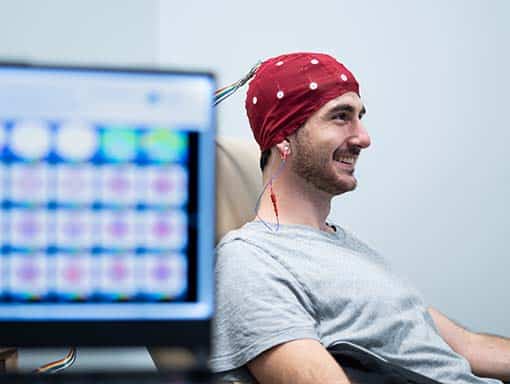
Neurofeedback for Fibromyalgia:
Neurofeedback has been very successful at reducing pain intensity and fatigue while improving sleep and cognitive function in people with FM. The protocols typically involve increasing sensorimotor rhythm (SMR) and alpha activity(14-15). SMR is associated with inhibitory control, so it’s increase may improve inhibition of perceived pain in those with FM, as well as sleep issues(16-17). Alpha activity is associated with a relaxed state, better processing speed, and improved executive function, so it’s increase may improve the dysfunctional brain activity seen in FM(18-19). In developing protocols for FM, we evaluate the individual’s EEG brain map, their clinical symptoms, and research to ensure the most effective protocol.
IV Therapy for Fibromyalgia:
Intravenous (IV) therapy like the Myer’s Cocktail, which contains Vitamin C, Magnesium, B Complex, and Vitamin B12 effectively decreases pain, fatigue, depression and improves quality of life in patients with fibromyalgia (FM)(20). Research has proposed that an imbalance of nutrients, elevated production of damaging free radicals, and reduced antioxidant capacity might play a significant role in FM(21,22). Combined, these issues can result in muscle pain, fatigue, and other FM symptoms. The Myer’s cocktail IV targets the root cause of these symptoms, and the benefits have been shown to last for up to four weeks following infusion (20).
Additionally, we offer Glutathione IV’s and pushes for those with FM. Glutathione is a potent antioxidant that reduces the damaging effects of free radicals, and its levels are low in FM(23). Increasing glutathione can help people with FM by decreasing elevated levels of free radicals, which is a main contributor to FM symptoms.

Pulsed Electromagnetic Field Therapy for Fibromyalgia:
Pulsed Electromagnetic Field Therapy (PEMF) has shown promising results in terms of improving function, pain, and fatigue in FM patients(24). Patients with fibromyalgia (FM) have been shown to have functional and structural changes in microcirculation compared to healthy controls(25). These structural changes lead to decreased oxygen and nutrient availability to the tissues. PEMF increases vasomotion in micro vessels, resulting in improvement in microcirculation. While PEMF alone can help improve symptoms of FM, combining it with HBOT and IV therapy can be a safe, powerful, and effective treatment for FM.
Recent Fibromyalgia News & Research:
Fibromyalgia developed after a TBI, how HBOT can help
A recent study by Healio, reports how Hyperbaric Oxygen Therapy improves symptoms among adults that develop fibromyalgia, after suffering from a Traumatic Brain Injury. Hyperbaric oxygen therapy improved pain symptoms, quality of life and social and emotional function...
Effects of Neurofeedback on Fibromyalgia: A Randomized Controlled Trial
Abstract Background: Fibromyalgia is a chronic widespread pain condition that is associated with sleep disturbances and cognitive impairments. Neurofeedback has been demonstrated to improve pain, sleep quality, and fatigue. However, few studies have examined the...
T helper 1 response is correlated with widespread pain, fatigue, sleeping disorders and the quality of life in patients with fibromyalgia and is modulated by hyperbaric oxygen therapy.
Abstract: Hyperbaric oxygen therapy (HBOT) has been used as treatment for different clinical conditions, including fibromyalgia (FM). HBOT modulates brain activity, ameliorates chronic pain and modifies the ratio of immune cells. Clinical studies have provided...
References
- Chinn, Steven, et al. “Fibromyalgia Pathogenesis and Treatment Options Update.” Current Pain and Headache Reports, vol. 20, no. 4, Feb. 2016, p. 25. Springer Link, doi:10.1007/s11916-016-0556-x.
- Fibromyalgia | Arthritis | CDC. 27 July 2020, https://www.cdc.gov/arthritis/basics/fibromyalgia.htm.
- Theoharides, Theoharis C., et al. “Fibromyalgia Syndrome in Need of Effective Treatments.” The Journal of Pharmacology and Experimental Therapeutics, vol. 355, no. 2, Nov. 2015, pp. 255–63. PubMed, doi:10.1124/jpet.115.227298.
- Bozkurt, Mehtap, et al. “Serum Prolidase Enzyme Activity and Oxidative Status in Patients with Fibromyalgia.” Redox Report: Communications in Free Radical Research, vol. 19, no. 4, July 2014, pp. 148–53. PubMed, doi:10.1179/1351000213Y.0000000079.
- Littlejohn, Geoffrey. “Neurogenic Neuroinflammation in Fibromyalgia and Complex Regional Pain Syndrome.” Nature Reviews. Rheumatology, vol. 11, no. 11, Nov. 2015, pp. 639–48. PubMed, doi:10.1038/nrrheum.2015.100.
- Yildiz, Ş., et al. “A New Treatment Modality for Fibromyalgia Syndrome: Hyperbaric Oxygen Therapy.” Journal of International Medical Research, vol. 32, no. 3, SAGE Publications Ltd, May 2004, pp. 263–67. SAGE Journals, doi:10.1177/147323000403200305.
- Atzeni, Fabiola, et al. “Hyperbaric Oxygen Treatment of Fibromyalgia: A Prospective Observational Clinical Study.” Clinical and Experimental Rheumatology, vol. 37 Suppl 116, no. 1, Feb. 2019, pp. 63–69.
- Efrati, Shai, et al. “Hyperbaric Oxygen Therapy Can Diminish Fibromyalgia Syndrome – Prospective Clinical Trial.” PLOS ONE, vol. 10, no. 5, Public Library of Science, May 2015, p. e0127012. PLoS Journals, doi:10.1371/journal.pone.0127012.
- Guedj, Eric, et al. “99mTc-ECD Brain Perfusion SPECT in Hyperalgesic Fibromyalgia.” European Journal of Nuclear Medicine and Molecular Imaging, vol. 34, no. 1, Jan. 2007, pp. 130–34. PubMed, doi:10.1007/s00259-006-0174-7.
- Guedj, Eric, et al. “Clinical Correlate of Brain SPECT Perfusion Abnormalities in Fibromyalgia.” Journal of Nuclear Medicine: Official Publication, Society of Nuclear Medicine, vol. 49, no. 11, Nov. 2008, pp. 1798–803. PubMed, doi:10.2967/jnumed.108.053264.
- Lin, Kao-Chang, et al. “Attenuating Inflammation but Stimulating Both Angiogenesis and Neurogenesis Using Hyperbaric Oxygen in Rats with Traumatic Brain Injury.” The Journal of Trauma and Acute Care Surgery, vol. 72, no. 3, Mar. 2012, pp. 650–59. PubMed, doi:10.1097/TA.0b013e31823c575f.
- Hui, Jie, et al. “Repetitive Hyperbaric Oxygen Treatment Attenuates Complete Freund’s Adjuvant-Induced Pain and Reduces Glia-Mediated Neuroinflammation in the Spinal Cord.” The Journal of Pain, vol. 14, no. 7, July 2013, pp. 747–58. PubMed, doi:10.1016/j.jpain.2013.02.003.
- Efrati, Shai, and Eshel Ben-Jacob. “Reflections on the Neurotherapeutic Effects of Hyperbaric Oxygen.” Expert Review of Neurotherapeutics, vol. 14, no. 3, Mar. 2014, pp. 233–36. PubMed, doi:10.1586/14737175.2014.884928.
- Kayiran, Sadi, et al. “Neurofeedback Intervention in Fibromyalgia Syndrome; a Randomized, Controlled, Rater Blind Clinical Trial.” Applied Psychophysiology and Biofeedback, vol. 35, no. 4, Dec. 2010, pp. 293–302. PubMed, doi:10.1007/s10484-010-9135-9.
- Wu, Yu-Lin, et al. “Effects of Neurofeedback on Fibromyalgia: A Randomized Controlled Trial.” Pain Management Nursing, Feb. 2021. ScienceDirect, doi:10.1016/j.pmn.2021.01.004.
- Egner, Tobias, and John H. Gruzelier. “Learned Self-Regulation of EEG Frequency Components Affects Attention and Event-Related Brain Potentials in Humans.” NeuroReport: For Rapid Communication of Neuroscience Research, vol. 12, no. 18, Lippincott Williams & Wilkins, 2001, pp. 4155–59. APA PsycNET, doi:10.1097/00001756-200112210-00058.
- Schabus, Manuel, et al. “Enhancing Sleep Quality and Memory in Insomnia Using Instrumental Sensorimotor Rhythm Conditioning.” Biological Psychology, vol. 95, Jan. 2014, pp. 126–34. ScienceDirect, doi:10.1016/j.biopsycho.2013.02.020.
- Plotkin, William B., and Kathleen M. Rice. “Biofeedback as a Placebo: Anxiety Reduction Facilitated by Training in Either Suppression or Enhancement of Alpha Brainwaves.” Journal of Consulting and Clinical Psychology, vol. 49, no. 4, American Psychological Association, 1981, pp. 590–96. APA PsycNET, doi:10.1037/0022-006X.49.4.590.
- Angelakis, Efthymios, et al. “EEG Neurofeedback: A Brief Overview and an Example of Peak Alpha Frequency Training for Cognitive Enhancement in the Elderly.” The Clinical Neuropsychologist, vol. 21, no. 1, Jan. 2007, pp. 110–29. PubMed, doi:10.1080/13854040600744839.
- Ali, Ather et al. “Intravenous micronutrient therapy (Myers’ Cocktail) for fibromyalgia: a placebo-controlled pilot study.” Journal of alternative and complementary medicine (New York, N.Y.) vol. 15,3 (2009): 247-57. doi:10.1089/acm.2008.0410
- Bjørklund G, Dadar M, Chirumbolo S, Aaseth J. Fibromyalgia and nutrition: Therapeutic possibilities?. Biomed Pharmacother. 2018;103:531-538. doi:10.1016/j.biopha.2018.04.056
- Cordero MD, de Miguel M, Carmona-López I, Bonal P, Campa F, Moreno-Fernández AM. Oxidative stress and mitochondrial dysfunction in fibromyalgia. Neuro Endocrinol Lett. 2010;31(2):169-173.
- Fatima, Ghizal & Das, Siddharth & Mahdi, Abbas Ali. (2016). To evaluate the level of oxidative and antioxidative parameters and its relationship with clinical symptoms in women with Primary Fibromyalgia Syndrome. International Journal of Infectious Diseases. 45. 223. 10.1016/j.ijid.2016.02.504.
- Sutbeyaz, Serap Tomruk MD; Sezer, Nebahat MD; Koseoglu, Fusun MD; Kibar, Sibel MD Low-frequency Pulsed Electromagnetic Field Therapy in Fibromyalgia, The Clinical Journal of Pain: October 2009 – Volume 25 – Issue 8 – p 722-728 doi: 10.1097/AJP.0b013e3181a68a6c
- Morf, Susanne et al. “Microcirculation abnormalities in patients with fibromyalgia – measured by capillary microscopy and laser fluxmetry.” Arthritis research & therapy vol. 7,2 (2005): R209-16. doi:10.1186/ar1459

